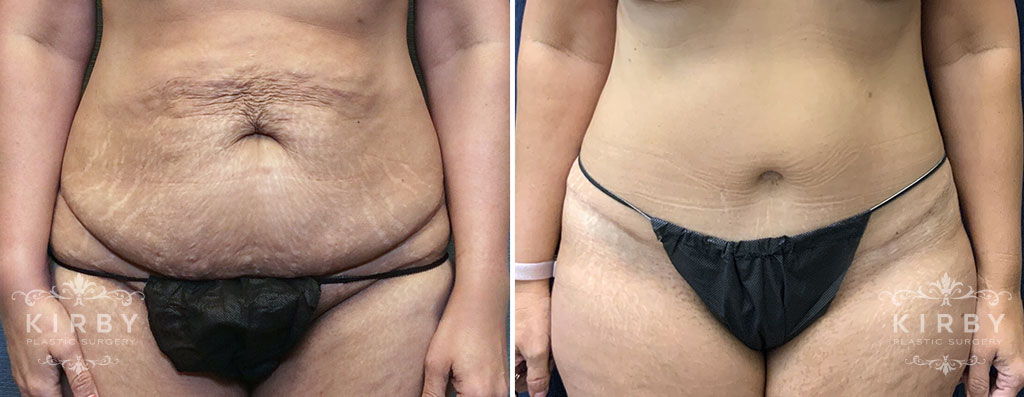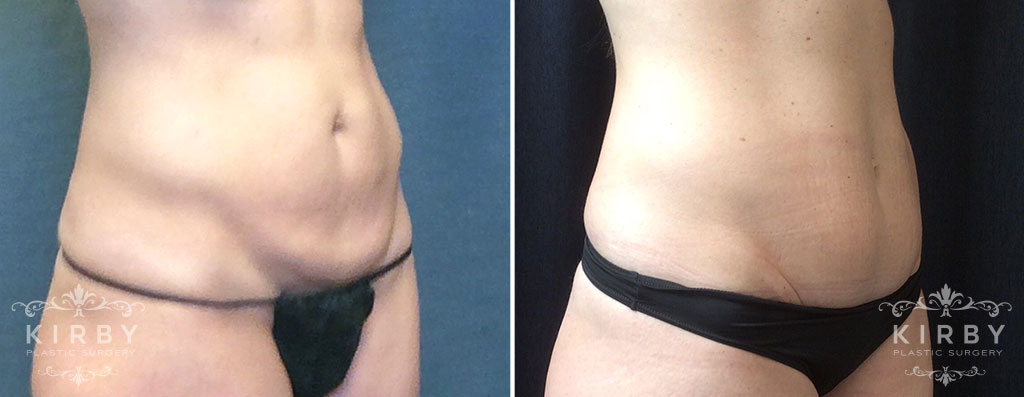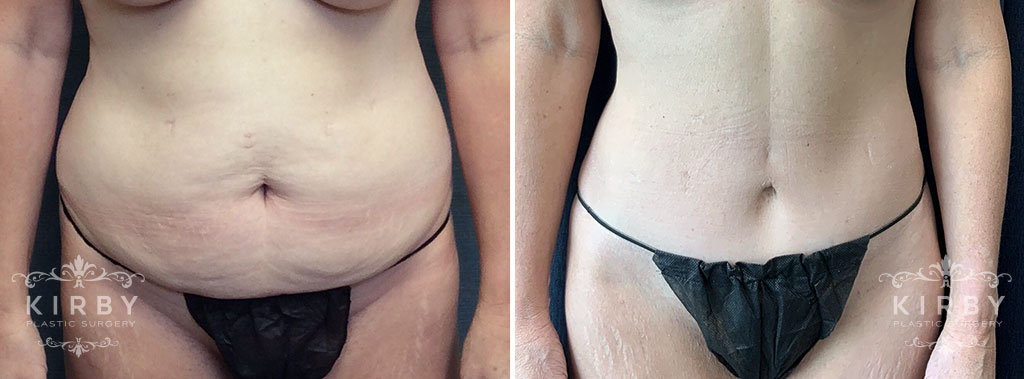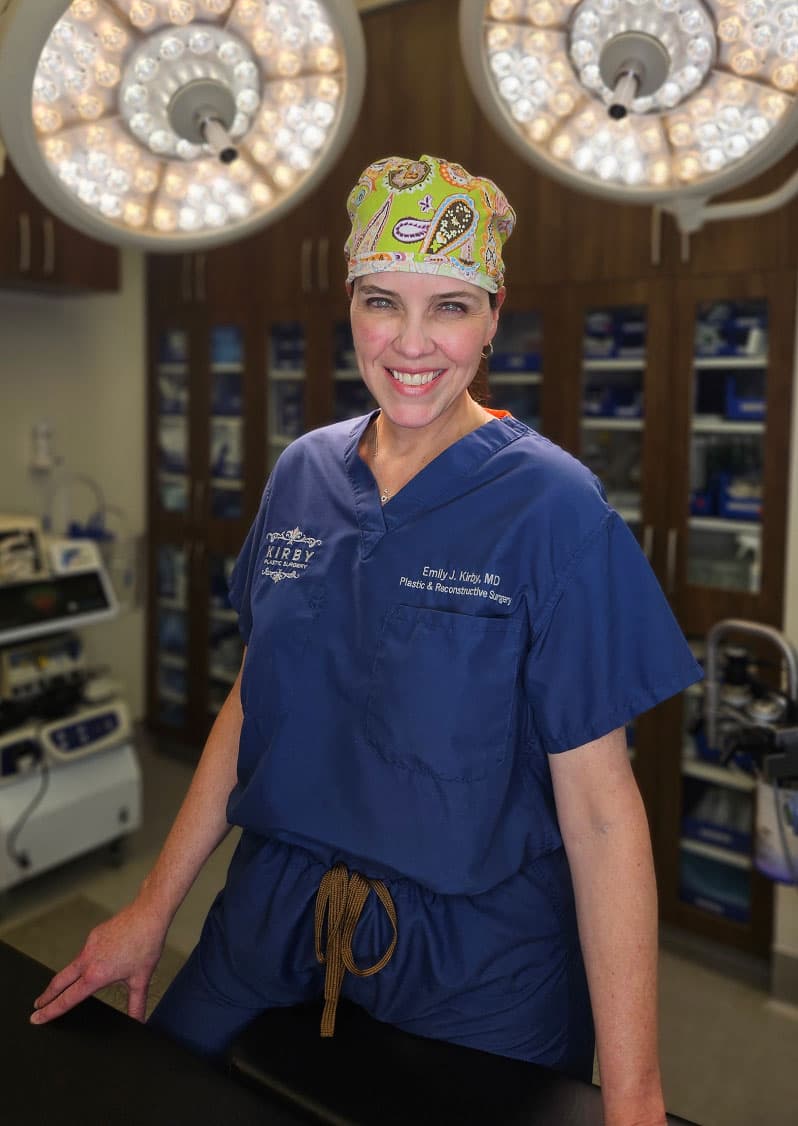Tummy Tuck Fort Worth (Abdominoplasty)

A tummy tuck, or abdominoplasty, is surgery to the abdomen that removes excess fat and skin. In additional to cosmetic benefits, it can also provide functional benefits, as it also restores weakened muscles to create a smoother, firmer abdominal profile.
Many of us strive to attain a flat, well-toned abdomen through exercise and weight control. However, sometimes these methods are not enough to achieve our goals. For individuals who have lost a significant amount of weight, there is no exercise that can restore elasticity to skin that has stretched beyond its ability to bounce back. Even individuals with normal body weight can have an abdomen that bulges or is loose and sagging. The most common causes of this are pregnancy, aging, changes in weight, genetics and previous surgery.
Board-Certified Plastic Surgeon Dr. Emily J. Kirby performs “tummy tuck” surgery, or abdominoplasty, to remove excess skin and fat from the abdominal wall. During a tummy tuck, she will tighten and restore your abdominal muscles back to their correct anatomical position, revealing your new shapely, contoured waist. Stretch marks and loose skin can be partially or totally removed in this increasingly popular surgical procedure.

This mommy makeover patient is shown before and after a tummy tuck with Dr. Kirby. Note the reduction of stretch marks and the improved appearance of her belly button.
Female Plastic Surgeon Fort Worth
- Board-Certified Plastic Surgeon
- Over 14 years of experience in private practice
- Founder and Medical Director of Kirby Plastic Surgery, Kalos Medical Spa, and City Surgery Center—a Quad A-accredited, state-of-the-art facility located onsite
- Specialist in breast surgery and body contouring, including postpartum
- Castle Connolly Top Doctor since 2019
- First female Chief of Plastic Surgery, Texas Health Resources Harris Methodist Hospital
Combining your tummy tuck with breast and body contouring
Liposuction is also frequently performed at the same time as a tummy tuck, in order to further enhance the shape of the lower abdomen. This procedure is also frequently included as part of a mommy makeover and it may be combined with a breast procedure.
Video transcript
“A tummy tuck, also called an abdominoplasty, is one of my favorite procedures. During an abdominoplasty, we remove excess tissue—whether it has stretch marks, is stretched out, or sags at the bottom—and contour the waist to create smooth, natural curves. Many people don’t realize that they actually keep their same belly button; it just looks a little different afterward. Beneath the surface, we also tighten the abdominal muscles, which often stretch due to weight gain, pregnancy, or life in general. Tightening those muscles restores core contour and helps you feel strong again.”
Techniques for tummy tuck surgery in Fort Worth, TX
Mini Abdominoplasty (Mini Tummy Tuck)
Mini abdominoplasty removes a moderate amount of skin from the lower abdomen without repositioning the belly button. It is specifically designed to help correct the appearance of bulging in the lower part of the abdomen, beneath the belly button. Though this technique results in the smallest scars, mini abdominoplasty is not a good technique for patients with significant amounts of excess skin on their entire abdomen. This will be better treated by full abdominoplasty. Furthermore, with this procedure, Dr. Kirby will not be able to address or tighten the muscles above the belly button, limiting this procedure to use in specific circumstances.
What is a mini tummy tuck?
A modified version of the abdominoplasty, a mini tummy tuck removes excess, sagging tissue from the lower abdomen (below the belly button) to restore a firmer, flatter and slimmer silhouette. Depending on your needs, Dr. Kirby can also remove some stretch marks located below the belly button during surgery or even tighten mildly lax muscles.
Whenever possible, Dr. Kirby uses drainless tummy tuck techniques to achieve beautiful results with a quicker, more comfortable recovery.

Am I a good candidate for a mini tummy tuck?
A mini tummy tuck may be a great option if you are healthy and at a stable weight, without a large excess of abdominal skin. Typically, the best candidates are primarily concerned about loose skin or a protruding lower belly only—this procedure is reserved for patients whose abdominal changes are down low. If you have significant stretched, sagging skin or muscles, a full tummy tuck may achieve better results.
Similar to a traditional tummy tuck, mini tummy tuck surgery is not a substitute for weight loss or a healthy exercise program. Although the results are lasting, the outcome can be influenced by changes in your weight following surgery. If you are planning substantial weight loss or if you are considering future pregnancy, you may be advised to postpone mini tummy tuck surgery.
Video transcript
“A lot of people come in asking for a mini tummy tuck, but not many are actually good candidates for it. A mini tummy tuck promises a shorter scar, which sounds ideal, but it also limits what I can do surgically. With a mini, we’re restricted in how much muscle tightening we can achieve, the amount of liposuction we can perform, and how much tissue can be removed. In many cases, a full tummy tuck is the better option because it allows for more comprehensive contouring and better overall results.”
Where will my mini tummy tuck incisions be?
The mini tummy tuck incision is much shorter than a traditional, full tummy tuck incision. This may be the only incision, and the belly button is allowed to “float” downwards to a new position without an additional belly button incision. Other techniques include a scar around the belly button. Incision placement is specific to your body and to your surgery, and Dr. Kirby will discuss the incisions with you prior to your surgery.
“Dr. Kirby and her staff are amazing. They go above and beyond to prepare you for surgery. I’ve honestly never seen a doctor cover all the bases like her team does. Very impressive. They instruct and prepare you for the best possible outcome both for surgery and recovery. They make you feel important and cared for. They sent me home with a care package that had pretty much everything I needed and then some to make recovery as comfortable as possible. I would absolutely use Dr. Kirby again and highly recommend her and her team”
What kind of anesthesia will I have?
Mini tummy tuck surgery is performed under general anesthesia for optimal comfort. This means you will be asleep for the entire procedure.
How long will my tummy tuck surgery last?
If performed alone, a mini tummy tuck typically takes 1-2 hours. The procedure may be performed in combination with other cosmetic procedures, such as liposuction or breast augmentation. Combination surgery will take longer.
Full Abdominoplasty (Tummy Tuck)
Full abdominoplasty removes lax skin, and fat, from above and below the belly button. The full tummy tuck repositions the belly button to a more proportionate spot. This procedure is best at treating patients who have a significant amount of skin laxity on their stomach, where changes in shape are desired above and below the belly button.
Using an incision that runs low from hipbone to hipbone, the doctor can tighten the muscle wall with sutures. This procedure may also be beneficial for patients with stretch marks below the belly button, although stretch mark removal is not guaranteed. The resulting scar is carefully positioned so that it is hidden from view by most clothing, and good surgical technique is essential to minimize scarring. A full tummy tuck is the most common type of abdominoplasty.

Extended Abdominoplasty
Extended abdominoplasty uses the longest incision of the three techniques, but it will also offer the most comprehensive results. This technique is usually reserved for those who have lost a large amount of weight and need the excess skin removed to show their slim, toned results. This procedure not only removes skin and repositions the belly button, but it also removes skin from the flanks, or love handles.
Your tummy tuck consultation
Your consultation takes about one hour. You’ll spend most of that time with Dr. Kirby discussing your goals, concerns, and questions, and learning how Dr. Kirby tailors the procedure to address each of these. You’ll also get to meet our nursing staff who will take your vitals and review your medical history, and our patient care coordinator will schedule your procedure and help guide you through the process from start to finish.
“From the beginning, it was apparent that Dr. Kirby is a caring individual who was interested in my welfare and recovery.”
GLP-1s & Abdominoplasty: What you need to know
If you are taking semaglutide or tirzepatide for weight management, let Dr. Kirby know during your consultation. It is important that you are at a stable weight when Dr. Kirby designs your surgery plan so your results are optimal and long-lasting.
We regularly see patients who take GLP-1 medication and are happy to recommend the right timing between ending the medication once you’ve reached your goals and performing your tummy tuck. We recommend you stop GLP-1 medication about 2-3 weeks before surgery to avoid anesthesia complications.
How much does a tummy tuck cost in Fort Worth, TX?
The cost of your tummy tuck with Fort Worth plastic surgeon Dr. Emily Kirby will depend on the extent of your procedure needed to achieve your desired goals (i.e. mini, standard, full, or extended abdominoplasty), as well as whether or not you choose to combine your surgery with liposuction, breast enhancement, or even additional non-surgical treatments. We do offer financing options to help making paying for your procedures as simple and seamless as possbile.
- Key Benefits
- Glossary
- Creates a flatter, more toned abdomen by removing excess skin and fat and tightening the underlying muscles
- May remove or reduce stretch marks on the lower abdomen
- Repairs abdominal muscle separation (diastasis recti), which is often caused by pregnancy
- May improve posture and support to the lower back due to the abdominal muscle tightening
- Hernia correction may be performed in the same surgery
- Abdominoplasty (Tummy Tuck): A surgical procedure that removes excess skin and fat from the abdomen and tightens the abdominal wall muscles to create a smoother, flatter abdominal profile.
- Compression Garment: A tight-fitting garment worn after surgery to reduce swelling, support the abdominal area, and help the skin conform to the new contours of the abdomen.
- Diastasis Recti: A condition characterized by the separation of the abdominal muscles, often as a result of pregnancy, which can be repaired during a tummy tuck procedure.
- Drain Tubes: Small tubes placed under the skin to remove excess fluids from the surgical area, often used after a tummy tuck to prevent fluid accumulation and reduce swelling.
- General Anesthesia: Medication administered to induce sleep and relaxation during surgery.
- Liposuction: A procedure that removes fat from specific areas of the body through suction, sometimes performed in conjunction with a tummy tuck to enhance body contouring results.
- Mini-Abdominoplasty: A less extensive version of the traditional tummy tuck, focusing on removing excess skin and fat from the lower abdomen without extensive muscle repair.
- Mounjaro®: The brand name for tirzepatide, Mounjaro® is a newer type of medication that acts on both GLP-1 and GIP (glucose-dependent insulinotropic polypeptide) receptors. This dual-action helps improve blood sugar control and promotes weight loss. It is approved for managing type 2 diabetes but has shown potential for weight management as well.
- Ozempic®: A brand name for semaglutide, a GLP-1 receptor agonist medication used primarily for the management of type 2 diabetes. Ozempic® works by mimicking the hormone GLP-1, which helps regulate blood sugar levels, slows gastric emptying, and promotes a feeling of fullness, supporting weight loss in some patients.
- Panniculectomy: A surgical procedure that removes only the excess skin and fat hanging over the genitals and thighs; distinct from a tummy tuck, which also tightens abdominal muscles.
- Postoperative Care: The care and instructions provided after a tummy tuck, including how to care for incisions, manage pain, and the timeline for returning to daily activities.
- Recovery Time: The period after surgery during which the patient heals. This includes time for swelling and bruising to subside, and for the patient to gradually return to normal activities, typically ranging from a few days to several weeks. Recovery can be streamlined, but not rushed.
- Rybelsus®: An oral form of semaglutide, Rybelsus® is used to control blood sugar levels in adults with type 2 diabetes. By activating GLP-1 receptors, it helps lower blood sugar by increasing insulin secretion, reducing appetite, and slowing down the absorption of food from the stomach.
- Scar Management: Techniques and treatments used to minimize the appearance of scars following a tummy tuck, such as silicone sheets, gels, and laser treatments.
- Skin Elasticity: The skin’s ability to stretch and return to its original state, an important factor in determining the outcome of a tummy tuck, as better elasticity typically leads to smoother results.
- Umbilicoplasty: Part of the tummy tuck procedure that involves repositioning or reshaping the belly button to achieve a natural-looking outcome.
- Wegovy®: Also a brand name for semaglutide, Wegovy® is specifically approved for weight management in individuals with obesity or who are overweight with weight-related medical conditions. It is a GLP-1 receptor agonist that helps reduce appetite, increase satiety, and ultimately support sustained weight loss when combined with lifestyle changes.
Tummy Tuck with TAP Block
Tummy tuck surgery will be performed under general anesthesia. Some patients may also benefit from a TAP nerve block, which is a special anesthesia technique that can reduce pain in the first days after surgery. TAP stands for “Transversus Abdominis Plane” and we use TAP blocks for many of our tummy tuck patients.
What is a TAP nerve block?
The TAP block is an injection of local anesthetic (numbing medication) into the neurovascular plane between the transversus abdominis muscle and internal oblique muscle, which the numbs the tissues of the lower abdomen from the belly button to the upper thigh. A TAP block prevents the nerves from sending pain signals from your surgical site, thereby reducing pain post-surgery.
How is a TAP block performed?
Proper placement of the TAP block is crucial for ensuring adequate numbing of the nerves that control sensation in the lower abdomen. During the surgery, Dr. Kirby uses ultrasound imaging to visualize your abdominal musculature. She then guides placement of the injection between the appropriate muscle layers of the abdominal wall.

How long does the TAP Block last after the tummy tuck surgery?
Pain relief from a single TAP block should last up to 12 to 24 hours. A TAP block does not eliminate pain entirely. You will still use additional pain medication after surgery, but patients report using less narcotic pain medication and for a shorter period of time when a TAP block has been performed.
As the TAP block wears off, you may begin to notice increased sensation slowly returning to your abdomen. It is a good idea to take your pain medication before the numbness has worn off fully to ensure you remain as comfortable as possible.
What are the possible risks of a TAP block?
Most complications are rare, but there are some risks associated with a TAP block—as with any injection. Typically, side effects are mild and short-lived, and may include:
- Infection at the injection site
- Local anesthetic systemic toxicity (LAST)
- Puncture of surrounding structures
By choosing a board certified plastic surgeon, these risks can be greatly reduced.
Dr. Emily Kirby ensures that every plastic surgery patient receives Enhanced Recovery After Surgery (ERAS) care to optimize recovery time and minimize pain. Dr. Kirby uses innovative pain reduction techniques, such as numbing anesthetics and small doses of different types of medications, to reduce discomfort from many angles.
“Dr. Kirby has created the most amazing experience. She is thorough and intuitive, sincerely cares about the work she does and perfectly marries listening to what you want and what science says.”
—Actual patient
What are the benefits of a TAP block?
Dr. Kirby has found that using a TAP block for tummy tuck patients comes with a number of benefits, including:
- Feeling less sedated and more alert after surgery
- Able to be up and walking sooner post-surgery
- Able to start eating a regular diet earlier after surgery
- More effective pain control
- Less constipation caused by narcotic pain medications
- Less nausea caused by narcotic pain medications
Many of Dr. Kirby’s tummy tuck patients opt for a TAP block to reduce discomfort after surgery so they can get settled at home and start the healing process.
What are drainless tummy tucks?
A drainless tummy tuck is a variation of the tummy tuck surgery that combines liposuction with a traditional tummy tuck and does so while using a specific layered suturing technique that eliminates the need for postsurgical drains.
Typical tummy tucks include a drain, or tubing, as part of the recovery process. Since your body naturally produces liquid as an immune response (swelling) after surgery, these drains collect excess liquid the body can’t absorb and allow it to move out of the abdominal cavity.
A drainless tummy tuck, in contrast, uses sutures to reduce the space between the skin and muscle tissue. Liquid from swelling then distributes evenly through the abdomen making the fluid collection less noticeable.
Dr. Kirby performs drainless tummy tucks whenever possible.
Video transcript
“Some people ask about a drainless abdominoplasty, and yes, we can do it—but the patient has to be the perfect candidate. First, they need to be very close to their goal weight, with a body mass index (BMI) that isn’t too high. Second, we need to ensure that we’re not performing too much liposuction at the same time. And third, the amount of tissue being removed can’t be too heavy. When all of these factors align, a drainless tummy tuck can be a great option.”
Real patient images from Board-Certified Plastic Surgeon Dr. Emily Kirby
*Individual results may vary.
How can I make my tummy tuck recovery easier?
Considering a tummy tuck, but dreading the downtime? In this video, Dr. Kirby explains the steps she takes to ensure her tummy tuck patients have the smoothest recovery possible.
Video transcript
“When we talk to friends about having a tummy tuck, we sometimes hear that they had a difficult recovery—and I don’t like that. I don’t like pain, and I don’t like causing pain. Over the years, I’ve refined how I manage patient discomfort, starting with prevention before surgery even begins. We focus on the nerves, inflammation, and muscles, dialing everything back before you even go into the procedure. During surgery, I also perform something called a TAP block using ultrasound. This allows me to place a long-acting local anesthetic around the nerves that supply the abdomen, significantly reducing post-surgical pain. As a result, many of our patients feel great and don’t even need narcotic pain medication after surgery, which is the ideal outcome.”
Minimizing scarring with Embrace scar therapy
Although Dr. Kirby takes care to place tummy tuck incisions low on the belly, where they can more easily be concealed by a swimsuit, she understands that you want the least noticeable scar possible, no matter what you are wearing! To help, Dr. Kirby offers Embrace® scar therapy, an FDA cleared treatment that is clinically proven to improve scar formation.
What is Embrace scar therapy?

Embrace strips are flexible, comfortable, and breathable clear silicone tape strips that gently contract around your incision to dramatically reduce tension, protect your healing incision, and create the optimal environment for healing. Our patients who use Embrace during their postoperative care are very happy they did—they have much thinner, lighter, and flatter scars in the months after tummy tuck surgery than they expected.

Embrace strips are easy to use and stay on for about 10 days each, even while showering and sleeping. Dr. Kirby and her team will show you how to use Embrace scar strips during your post-operative visits if you choose to use it.
Tummy tuck surgery FAQ
References »
Matarasso A, Swift RW, Rankin M. Abdominoplasty and abdominal contour surgery: a national plastic surgery survey. Plastic and Reconstructive Surgery. 2006. doi: 10.1097/01.prs.0000209918.55752.f3.
Swanson E. Prospective Clinical Study of 551 Cases of Liposuction and Abdominoplasty Performed Individually and in Combination. 2013. Plastic and Reconstructive Surgery Global Open.
Shermak MA. Abdominoplasty with Combined Surgery. Clinics in Plastic Surgery. 2020 Jul;47(3):365-377. doi: 10.1016/j.cps.2020.02.001.
Pollock TA, Pollock H. Progressive tension sutures in abdominoplasty: a review of 597 consecutive cases. Aesthetic Surgery Journal. 2012 Aug;32(6):729-42. doi: 10.1177/1090820X12452294.
Luis H. Macias, Edwin Kwon, Daniel J. Gould, Michelle A. Spring, W. Grant Stevens, Decrease in Seroma Rate After Adopting Progressive Tension Sutures Without Drains: A Single Surgery Center Experience of 451 Abdominoplasties Over 7 Years, Aesthetic Surgery Journal, Volume 36, Issue 9, October 2016, Pages 1029–1035, https://doi.org/10.1093/asj/sjw040
Area Served:
- Fort Worth TX
- Southlake
- Discuss your goals and concerns
- Obtain a unique female perspective for tummy tucks
- Review convenient financing options
- Call or text (817) 292-4200, or contact us online!

Medically reviewed by Dr. Emily J. Kirby — Updated on Mar 21, 2025
